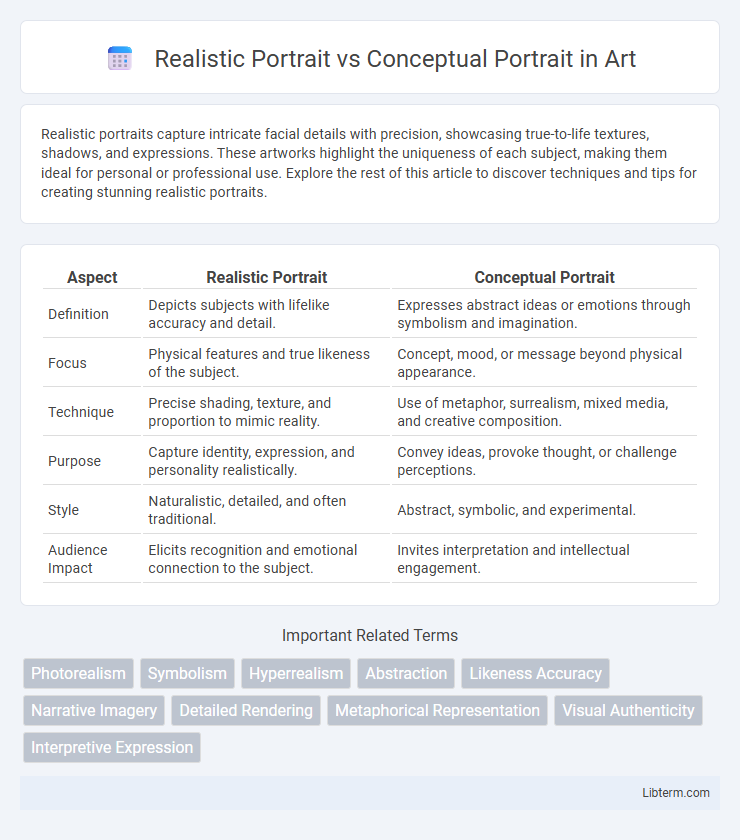Realistic portraits capture intricate facial details with precision, showcasing true-to-life textures, shadows, and expressions. These artworks highlight the uniqueness of each subject, making them ideal for personal or professional use. Explore the rest of this article to discover techniques and tips for creating stunning realistic portraits.
Table of Comparison
| Aspect | Realistic Portrait | Conceptual Portrait |
|---|---|---|
| Definition | Depicts subjects with lifelike accuracy and detail. | Expresses abstract ideas or emotions through symbolism and imagination. |
| Focus | Physical features and true likeness of the subject. | Concept, mood, or message beyond physical appearance. |
| Technique | Precise shading, texture, and proportion to mimic reality. | Use of metaphor, surrealism, mixed media, and creative composition. |
| Purpose | Capture identity, expression, and personality realistically. | Convey ideas, provoke thought, or challenge perceptions. |
| Style | Naturalistic, detailed, and often traditional. | Abstract, symbolic, and experimental. |
| Audience Impact | Elicits recognition and emotional connection to the subject. | Invites interpretation and intellectual engagement. |
Introduction to Portrait Art
Realistic portrait art emphasizes lifelike representation with precise details, capturing the true appearance and personality of the subject. Conceptual portrait art explores abstract ideas and emotions, using symbolic elements to convey deeper meanings beyond physical likeness. Both styles offer unique approaches to portraiture, blending technical skill with creative expression in the art world.
Defining Realistic Portraits
Realistic portraits prioritize lifelike representation, capturing intricate facial features, skin texture, and accurate lighting to reflect true human expression. They emphasize precise anatomical proportions and minute details to create a faithful reproduction of the subject's appearance. This style contrasts with conceptual portraits, which use symbolism and abstract elements to convey ideas beyond mere visual accuracy.
Exploring Conceptual Portraits
Conceptual portraits challenge traditional photography by emphasizing ideas, emotions, and symbolism over mere likeness, creating deeper narrative layers. These portraits use abstract elements, unconventional poses, and creative lighting to evoke thought and invite interpretation. Exploring conceptual portraits enhances artistic expression and pushes the boundaries of visual storytelling beyond realistic depiction.
Key Differences Between Realistic and Conceptual Portraits
Realistic portraits emphasize precise, lifelike representation of the subject, focusing on accurate anatomy, texture, and lighting to capture true physical appearance. Conceptual portraits prioritize expressing abstract ideas, emotions, or narratives, often using symbolic elements, unconventional techniques, or imaginative settings to convey deeper meanings. The key difference lies in the intention: realistic portraits aim for visual accuracy, while conceptual portraits explore artistic interpretation and storytelling.
Techniques Used in Realistic Portraiture
Realistic portraiture employs techniques such as precise anatomical drawing, accurate shading to capture light and shadow, and detailed texture rendering to create lifelike images. Artists extensively use tools like graphite pencils, charcoal, and oil paints to achieve smooth gradations and depth, emphasizing proportion and perspective. Mastery of color theory and meticulous observation of facial features ensure the final portrait closely resembles the subject's true appearance.
Techniques Used in Conceptual Portraiture
Conceptual portraiture employs techniques such as exaggerated lighting, symbolic props, and abstract backgrounds to convey emotions and ideas beyond physical accuracy. Artists often manipulate color schemes, use digital editing, or incorporate mixed media to enhance the narrative and psychological impact. These methods contrast with the precise brushwork and naturalistic details favored in realistic portraiture, emphasizing interpretation over representation.
The Role of Emotion and Storytelling
Realistic portraits capture precise facial features and expressions to convey authentic emotions, allowing viewers to connect deeply with the subject's true personality. Conceptual portraits use symbolic elements and abstract visuals to tell a layered story, evoking emotions beyond physical appearance. Emotion and storytelling in both styles shape the viewer's interpretation, where realism grounds the narrative in visible reality while conceptual art invites imagination and personal meaning.
Popular Artists and Iconic Works
Realistic portrait artists like Chuck Close and Lucian Freud are celebrated for their meticulous attention to detail and lifelike representations, with iconic works such as Close's "Big Self-Portrait" and Freud's "Benefits Supervisor Sleeping." Conceptual portrait artists including Cindy Sherman and Yinka Shonibare challenge traditional notions of identity and representation through imaginative and symbolic imagery, exemplified by Sherman's "Untitled Film Stills" and Shonibare's "Mr. and Mrs. Andrews." Both styles remain influential in contemporary art, shaping diverse approaches to portraiture that explore human experience and visual narrative.
Choosing the Right Portrait Style
Selecting the right portrait style depends on the purpose and emotional impact desired; realistic portraits emphasize lifelike details and accurate representation, ideal for capturing true likeness and personality. Conceptual portraits prioritize creative expression and symbolism, often incorporating abstract elements to convey deeper narratives or themes. Understanding the context and message helps artists and clients decide between the precision of realism and the imaginative freedom of conceptual artistry.
Future Trends in Portraiture
Realistic portraiture continues to evolve with advancements in AI-driven imaging and hyper-realistic rendering techniques, allowing artists to capture unprecedented detail and lifelike textures. Conceptual portraiture is increasingly integrating virtual and augmented reality, enabling immersive storytelling that expands the boundaries of traditional representation. Future trends indicate a convergence of both styles, leveraging technology to blend accurate likeness with imaginative, multi-sensory experiences.
Realistic Portrait Infographic

 libterm.com
libterm.com